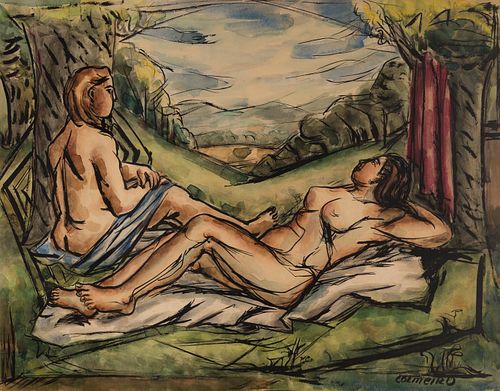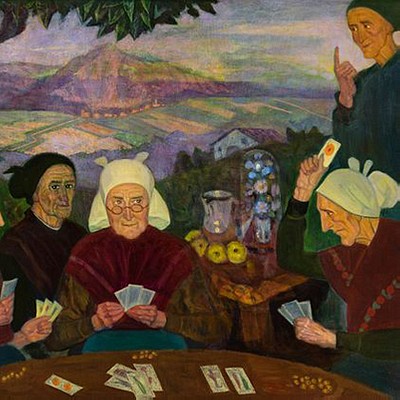MANUEL COLMEIRO GUIMARÁS (Pontevedra, 1901 - Salvaterra do Minho, Pontevedra, 1999). "Women and landscape", c. 1933. Ink and watercolor on paper.
Lot 18
About Seller
Setdart Auction House
Carrer Aragó 346
Barcelona
Spain
Setdart Subastas was born in 2004 and is currently the first online art auction in Spain with solidity, prestige and reliability guaranteed by our more than 60,000 users. Setdart has a young, dynamic and enterprising team ready to successfully manage the purchase and sale of art works through custom...Read more
Categories
Estimate:
EUR€5,000 - EUR€7,000
$5,208.33 - $7,291.67
Absentee vs Live bid
Two ways to bid:
- Leave a max absentee bid and the platform will bid on your behalf up to your maximum bid during the live auction.
- Bid live during the auction and your bids will be submitted real-time to the auctioneer.
Bid Increments
| Price | Bid Increment |
|---|---|
| EUR€0 | EUR€10 |
| EUR€200 | EUR€25 |
| EUR€500 | EUR€50 |
| EUR€1,000 | EUR€100 |
| EUR€3,000 | EUR€200 |
| EUR€5,000 | EUR€500 |
| EUR€10,000 | EUR€1,000 |
| EUR€20,000 | EUR€2,000 |
| EUR€50,000 | EUR€5,000 |
About Auction
By Setdart Auction House
Dec 14, 2021
Set Reminder
2021-12-14 08:00:00
2021-12-14 08:00:00
America/New_York
Bidsquare
Bidsquare : 19th & 20th Century Fine Art
https://www.bidsquare.com/auctions/setdart-auction-house/19th-20th-century-fine-art-7992
Gaudi, Sorolla, Torres Garcia, Maclet, TSUGUHARU FOUJITA, Benjamin Palencia Setdart Auction House sofia@setdart.com
Gaudi, Sorolla, Torres Garcia, Maclet, TSUGUHARU FOUJITA, Benjamin Palencia Setdart Auction House sofia@setdart.com
- Lot Description
MANUEL COLMEIRO GUIMARÁS (Pontevedra, 1901 - Salvaterra do Minho, Pontevedra, 1999). "Women and landscape", c. 1933. Ink and watercolor on paper. Presents label on the back label of the Gallery Montenegro Vigo. Measurements: 50 x 65 cm, 77.5 x 91 cm (frame). In this work of youth we can appreciate the aesthetic links of Manuel Colmeiro with artists like Cézanne and Matisse. A work that shows the artist's interest in the Greco-Latin world, and the representation of bathers. It is true that Colmeiro's work stood out for the great prominence of his native land in his painting, however, from 1933 to 1936 he introduced in his painting the theme of bathers as in this particular case. A Galician painter who emigrated to Buenos Aires, Manuel Colmeiro combined his artistic studies there at night with work in a shoe factory. For a year he studied at the Academy of Fine Arts, which he nevertheless abandoned to form a working group with other painters and sculptors. After this stage, where he developed an expressionist work, he returned to Galicia in 1926. Two years later he held his first exhibition in the salons of Faro de Vigo, and soon obtained a scholarship from the Diputación de Pontevedra to travel to Madrid and further his training at the Academia de Bellas Artes de San Fernando. In the capital, Manuel Colmeiro showed, however, a greater interest in studying first-hand the great masters at the Prado Museum. He continued to make himself known, and in 1932 he took part in an exhibition of new Galician painters at Federico García Lorca's Barraca. However, when the civil war broke out, he went back to Buenos Aires, where he remained until 1948. During this second period in Argentina he will be in contact with Luis Seoane, Rafael Dieste and Rafael Alberti, among others. In 1949 he moved to Paris, where he remained for decades, until 1989, when he returned definitively to Galicia. In fact, Colmeiro is considered part of the Spanish School of Paris. In the 1960s he achieved massive international recognition, with solo exhibitions in London, Paris and Madrid. During these years his work is already focused on popular Galician themes, its culture and its people. He was part of the group known as "Os Novos" or "Os Renovadores", together with Seoane, Laxeiro, Arturo Souto and Maside. All of them, born at the beginning of the 20th century, were considered continuators of the "Nós Generation", and had in common a work with Galician themes combined with avant-garde aesthetics, mainly expressionism, cubism and abstraction. Among them, Colmeiro stood out for the intimate air of his images, accompanied by a lyrical concept of atmospheres, and in fact he was considered the most attached to the tradition of the group. Throughout his career, this artist was awarded several prizes, including the Prêmio das Artes de la Junta de Galicia in 1987 and the Prêmio Celanova, Casa dos Poetas in 1996. He is currently represented in the Afundación Collection, the María José Jove Foundation, the Abanca Collection and the Museum of Pontevedra, among other collections.
- Shipping Info
-
In-house shipping available. Please inquire at admin@setdart.com.
-
- Buyer's Premium



 EUR
EUR CAD
CAD AUD
AUD GBP
GBP MXN
MXN HKD
HKD CNY
CNY MYR
MYR SEK
SEK SGD
SGD CHF
CHF THB
THB
















